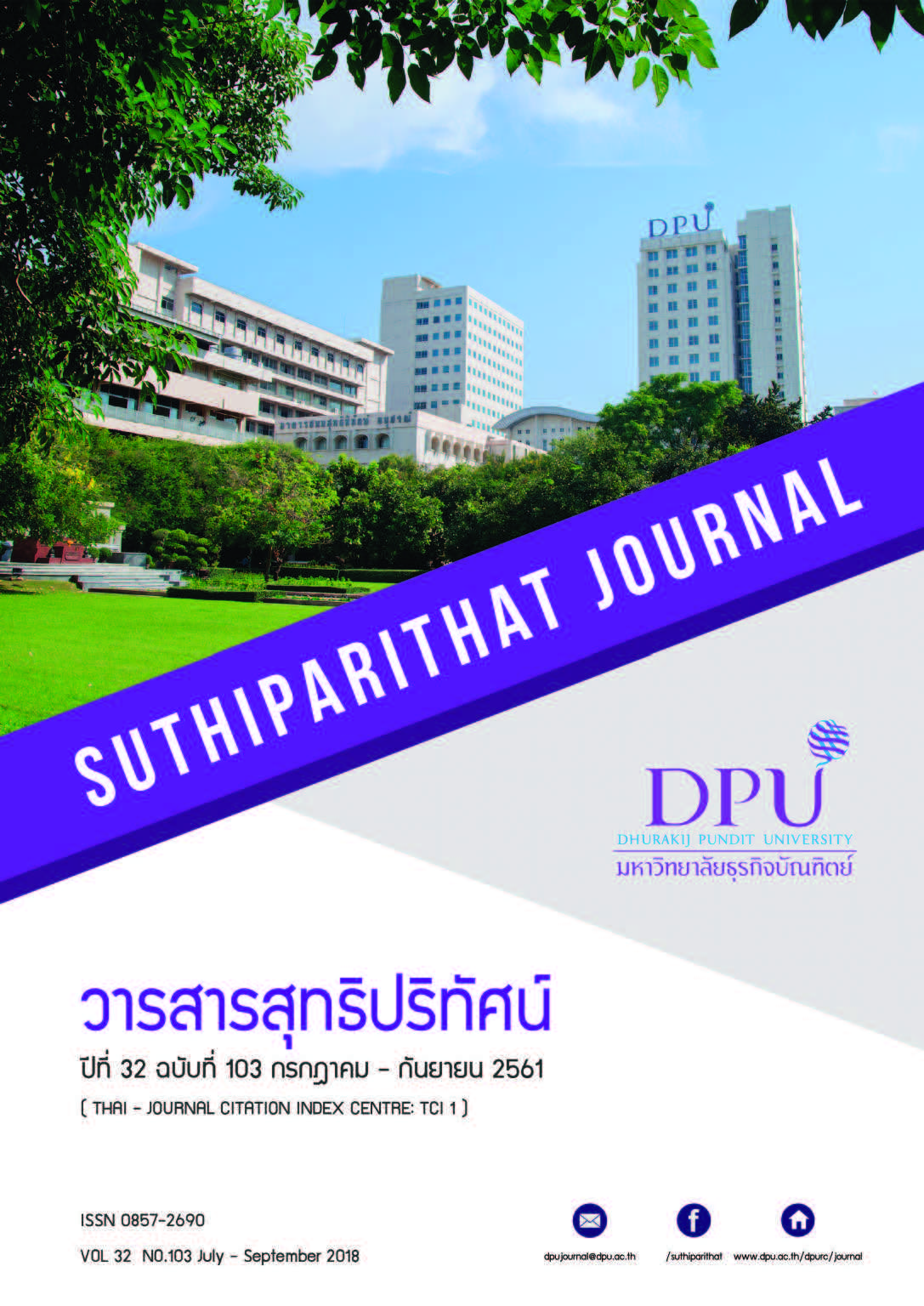อิทธิพลของการจัดการทรัพยากรมนุษย์ที่มีต่อความตั้งใจคงอยู่ของพนักงานวิศวกรกลุ่มเจเนอเรชั่นวาย ในเขตนิคมอุตสาหกรรม จังหวัดระยอง
คำสำคัญ:
การจัดการทรัพยากรมนุษย์, ความตั้งใจคงอยู่, เจเนอเรชั่นวายบทคัดย่อ
การวิจัยครั้งนี้มีวัตถุประสงค์เพื่อ 1) ศึกษาระดับความตั้งใจคงอยู่ของพนักงาน 2) ประเมิน การจัดการทรัพยากรมนุษย์ที่เป็นอยู่ของพนักงาน และ 3) วิเคราะห์อิทธิพลของการจัดการทรัพยากรมนุษย์ ที่มีต่อความตั้งใจคงอยู่ของพนักงาน โดยกลุ่มตัวอย่างประกอบด้วยพนักงานวิศวกรกลุ่มเจเนอเรชั่นวายใน เขตนิคมอุตสาหกรรม จังหวัดระยอง จำนวน 405 คน เครื่องมือที่ใช้เก็บรวบรวมข้อมูลเป็นแบบสอบถาม สถิติที่ใช้ในการวิเคราะห์ข้อมูล ได้แก่ ค่าความถี่ ค่าเฉลี่ย ค่าร้อยละ ส่วนเบี่ยงเบนมาตรฐาน การวิเคราะห์ องค์ประกอบ และการวิเคราะห์ถดถอยเชิงพหุ
ผลการวิจัยพบว่า พนักงานวิศวกรกลุ่มเจเนอเรชั่นวายในเขตนิคมอุตสาหกรรม จังหวัดระยอง มีระดับความตั้งใจคงอยู่ในระดับสูง ผลการสกัดองค์ประกอบการจัดการทรัพยากรมนุษย์ที่เป็นอยู่ได้ องค์ประกอบทั้งหมด 10 องค์ประกอบ ได้แก่ ค่าตอบแทน การออกแบบงาน การพัฒนาอาชีพ สิ่งจูงใจ และผลประโยชน์เกื้อกูล การวิเคราะห์งาน ความสมดุลระหว่างชีวิตและการทำงาน การฝึกอบรมและ พัฒนา พนักงานและแรงงานสัมพันธ์ การจัดการผลการปฏิบัติงาน และความปลอดภัยของพนักงาน โดยทำการประเมินระดับการจัดการทรัพยากรมนุษย์ทั้ง 10 องค์ประกอบพบว่ามีการปฏิบัติอยู่ในระดับมาก ทุกองค์ประกอบ ซึ่งจากการวิเคราะห์อิทธิพลของการจัดการทรัพยากรมนุษย์ที่มีต่อความตั้งใจคงอยู่ของพนักงานวิศวกรกลุ่มเจเนอเรชั่นวายพบว่าการจัดการทรัพยากรมนุษย์ด้านค่าตอบแทน การพัฒนาอาชีพ ความสมดุลระหว่างชีวิตและการทำงาน และการฝึกอบรมและพัฒนา มีอิทธิพลต่อความตั้งใจคงอยู่ของ พนักงานกลุ่มเจเนอเรชั่นวายอย่างมีนัยสำคัญทางสถิติที่ระดับ 0.05
เอกสารอ้างอิง
การนิคมอุตสาหกรรมแห่งประเทศไทย. (2560). นิคมอุตสาหกรรมในประเทศไทย. สืบค้น 2 กรกฎาคม 2560, จาก http://www.ieat.go.th/investment/about-industrial-estates/industrial-estates-in-thailand.
กานต์พิชชาเก่งการช่าง. (2556). เจนเนอเรชั่นวายกับความท้าทายใหม่ในการบริหารทรัพยากรบุคคล. วารสารสังคมศาสตร์และศิลปศาสตร์, 2(1), 15-27.
ชญาภา เจนวณิชย์วิบูลย์. (2554). ความสัมพันธ์ระหว่างการมีจิตใจเป็นเจ้าของความผูกพันต่อองค์การและความตั้งใจคงอยู่ในงานของพนักงานสัญญาจ้าง กรณีศึกษาบริษัทสำรวจและผลิตปิโตรเลียมแห่งหนึ่ง (ปริญญานิพนธ์ศิลปศาสตร์มหาบัณฑิต). กรุงเทพฯ: มหาวิทยาลัยธรรมศาสตร์.
เดชา วัฒนไพศาล. (2552). การรับรู้คุณลักษณะของเจนเนอเรชั่นวายและแรงจูงใจในการทำงาน: มุมมองระหว่างเจนเนอเรชั่นต่างๆ ในองค์กร. จุฬาลงกรณ์ธุรกิจปริทัศน์, 31(121), 1-25.
นงนุชเจดีย์แปง. (2550). ปัจจัยที่ส่งผลต่อความตั้งใจคงอยู่กับองค์การของพนักงานระดับปฏิบัติงานบริษัทผู้ผลิตเครื่องสำอางแห่งหนึ่ง (วิทยานิพนธ์วิทยาศาสตร์มหาบัณฑิต). กรุงเทพฯ: มหาวิทยาลัยรามคำแหง.
นิตยา วันทยานันท์. (2559). ปัจจัยที่มีความสัมพันธ์กับความตั้งใจคงอยู่ในงานของพยาบาลวิชาชีพ กลุ่มลูกจ้างชั่วคราว โรงพยาบาลในเขตจังหวัดสกลนคร (ปริญญานิพนธ์พยาบาลศาสตร์มหาบัณฑิต). ชลบุรี: มหาวิทยาลัยบูรพา.
ประคัลภ์ ปัณฑพลังกูร. (2555). การบริหารจัดการ Gen Y. สืบค้น 2 กรกฎาคม 2560, จาก https://prakal.wordpress.com/2012/06/20การบริหารจัดการ-gen-y.
พงศธร อุปถัมภ์, อรพิณ สันติธีรากุล, และเขมกร ไชยประสิทธ์. (2559). ความสมดุลระหว่างชีวิตและการทำงานของเจนเนอเรชั่นวายในอำเภอเมืองเชียงใหม่. วารสารบริหารธุรกิจ มหาวิทยาลัยเชียงใหม่, 2(3), 522-536.
เสาวคนธ์ วิทวัสโอฬาร. (2550). Gen Y จับให้มั่นคั้นให้เวิร์ค. กรุงเทพมหานคร: กรุงเทพธุรกิจ บิซบุ๊ค.
Bowin, R. B., & Harvey, D. F. (1996). Humanresource management: An experimental approach. Mahwah, NJ: Prentice-Hall.
Cole, J. (1999). The art of wooing gen xer. HR Focus, 76(11), 7-8.
Cochran, W. G. (1953). Sampling Techiques. New York: John Wiley & Sons. Inc.
Costen, W. M., & Salazar, J. (2011). The impact of training and development on employee job satisfaction, loyalty, and intent to stay in the lodging industry. Journal of Human Resources in Hospitality and Tourism, 10(3), 273-284.
Daft, R. L., & Marcic, D. (2013). Management: The new workplace (8th ed.). Mason, OH: South-Western Cengage Learning.
Dias, L. P. (2011). Beginning management of human resources v.0. Retrieved July, 15, from https://2012books.lardbucket.org/pdfs/beginning-management-of-human-resources.pdf.
Downs, K. (2009). Managing generation y in recessionary times. Business Credit, 111(4), 29.
Erickson, T. (2008). Plugged in: The Generation Y Guide to Thriving at Work. Boston: Harvard Business Press.
Gilbert, J. (2011). The millennials: A new generation of employees, a new set of engagement policies. Ivey Business Journal, 75 (5), 26-28.
Howe, N., & Strauss, W. (2000). Millennials rising: The next great generation. New York: Vintage Books.
Irvine, D. (2010). How to reward a multigenerational and culturally diverse workforce. Workspan:The Magazine of Worldat Work, 4(10), 63–68.
Ivancevich, J. M. (2010). Human resource management (11th ed.). New York: McGraw-Hill.
Lancaster, L. C., & Stillman, D. (2010). The M-factor. New York: Harper Collins.
Liew, J. W., Rahman, S. Patah, R. H., & Rahman A. A. (2016). The relationship between HRM strategies and intention to stay. Journal of Advanced Research in Social and Behavioral Sciences, 4(1), 90-98.
Lieber, L. D. (2010). How HR can assist in managing the four generations in today’s workplace. Employment Relations Today, 36(4), 85-91.
Lloyd, J. (2007). The truth about gen y. Marketing Magazine, 112(19), 12-22.
Ma, E. J. (2010). A cross-culture study on the motivational mechanism of hotel employees’organizational citizenship behavior (Doctor of Philosophy). Stillwater, OK: Oklahoma State University.
Mathis, R. L., & Jackson, J. H. (2011). Human Resource Management (13th ed.). Mason, OH:South-Western Cengage Learning.
Mburu, A. W. (2015). Effects of human resource management practices on employee retention in deposit-taking microfinance institutions (MFIs) in Kenya (Degree of Master in Business Administration). Kenya: University of Nairobi.
Mc Carthy, G., Tyrrell M.P., & E. Lehane. 2007. Intention to leave or stay in nursing. Journal of Nursing Management, 15, 248-255.
Mc Closkey, M., & Joanne, C. (1990). Two requirements for job contentment: autonomy and socialintegration. Journal of Scholarship, 22(3), 140-143.
Mitchel, J. O. (1981). The effect of intentions, tenure, personal and organizational variables on managerial turnover. The Academy of Management Journal, 24(4), 742-751.
Mondy, R. W., & Mondy, J. B. (2016). Human resource management (13th ed.). Boston: Pearson Education.
Mondy, R. W., & Mondy, J. B. (2014). Human Resource Management (13th ed.). England: Pearson Education Limited.
Mondy, R. W., & Noe, R. M. (1996). Human resource management. Mahwah, NJ: Prentice-Hall.
Mowday, R., Porter, L. W., & Steer, R. M. (1982). Employee-organization linkages: The psychology of commitment, absenteeism, and turnover. New York: Academic Press.
Myers, K. (2010). Millennials in the workplace: A communication perspective on millennials, organizational relationships and performance. Journal of Business and Psychology, 25, 225-238.
Nasyira, M. N., Othman M., & Ghazali, H. (2014). Predictors of intention to stay for employees of casual dining restaurant in Klang Valley area. International Food Research Journal, 21(3), 863-871.
Neuhauser, P. C. (2002). Building a high-retention culture in healthcare: Fifteen ways to get good people to stay. Journal of Nursing Admimistration, 32(9), 470.
Noe, R. A., Hollenbeck, J. R., Gerhart, B., & Wright, P. M. (2011). Fundamentals of human resource management (4th ed.). New York: McGraw-Hill.
Oluwaseun, I. S. (2016). Theeffect of employee empowerment and job satisfaction on intention to stay in Nigeria banking industry: A case study of guaranty trust bank (Degree of Master in Business Administration). Northern Cyprus: Eastern Mediterranean University.
Othman, S. M., & Lembang, S. A. (2017). What attract gen y to stay in organization? hr practices, organizational support or leadership style. International Review of Management and Marketing, 7(2), 1-9.
Pitcher, J. & Purcell, K. (1998). Diverse expectations and access to opportunities: is there agraduate labor market?. Higher Education Quarterly, 52(2), 179-203.
Pynes, J. E. (2009). Human resource management for pubic and nonprofit oraganizations (3rd ed.). San Francisco, CA: John Wiley & Sons.
Ramzan, M., & Riaz, A.(2013). The impact of employee turnover on the efficiency of the organization. Interdisciplinary Journal of Contemporary Research in Business, 4(9), 700-711.
Taunton, R. L., Krampitz S.D., & Wood, J.H.(1989). Manager impact on retention of hospital staff: Part 1. Journal of Nursing Administration, 19(3), 17.
Wangu, M. P. (2016). Human resource management strategies for the retention of generation Y employees: A case of Union Des Assurances De Paris Insurance Company Limited (Degree of Masters in Business Administration). Kenya: United States International University.
Zemke, R., Raines C.,&Filipczak, B. (2013). Generations at work: Managing the clash of boomers, gen xers, and gen yers in the workplace (2nd ed.). New York: American Management Association.
ดาวน์โหลด
เผยแพร่แล้ว
รูปแบบการอ้างอิง
ฉบับ
ประเภทบทความ
สัญญาอนุญาต
เนื้อหาและข้อมูลในบทความที่ลงตีพิมพ์ในวารสารสุทธิปริทัศน์ ถือเป็นข้อคิดเห็นและความรับผิดชอบของผู้เขียนบทความโดยตรงซึ่งกองบรรณาธิการวารสาร ไม่จำเป็นต้องเห็นด้วย หรือร่วมรับผิดชอบใด ๆ
บทความ ข้อมูล เนื้อหา รูปภาพ ฯลฯ ที่ได้รับการตีพิมพ์ในวารสารสุทธิปริทัศน์ ถือเป็นลิขสิทธิ์ของวารสารสุทธิปริทัศน์หากบุคคลหรือหน่วยงานใดต้องการนำทั้งหมดหรือส่วนหนึ่งส่วนใดไปเผยแพร่ต่อหรือเพื่อกระทำการใด ๆ จะต้องได้รับอนุญาตเป็นลายลักษณ์อักษรจากวารสารสุทธิปริทัศน์ก่อนเท่านั้น







